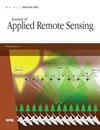Spatio-temporal analysis and volumetric characterization of interferometric synthetic aperture radar-observed deformation signatures related to underground and in situ leach mining
IF 1.4
4区 地球科学
Q4 ENVIRONMENTAL SCIENCES
引用次数: 0
Abstract
The effect of uranium mining on ground deformation is a relatively unexplored area, especially in terms of surface subsidence related to subsurface ore removal. We use interferometric synthetic aperture radar and spatiotemporal techniques to characterize subsidence signals at the McArthur River underground mine in Canada and the Four Mile in situ leach mine in Australia. We enhance the signal-to-noise ratio of our datasets via time-series techniques and compare results from active periods with results during inactivity to establish a baseline for mining-related signals. We then relate observed surface subsidence to subsurface volumetric strain rates via a voxel parameterization and Bayesian, geostatistical inversion. We use priors on our volumetric strain rates to identify whether these rates are best attributed to ore removal or if additional factors are contributing to subsidence at these sites. We find that the subsidence at McArthur River is best explained by a combination of ore removal and thermal contraction resulting from ground freezing practices. Ore removal via solution extraction alone explains the subsidence at Four Mile, although the localized subsidence pattern and resulting strain rates suggest an intricate combination of sinks and sources in the field, possibly from injection and production well locations and the subsequent flow of solution.干涉合成孔径雷达观测地下和原地浸出开采变形特征的时空分析和体积表征
铀矿开采对地面变形的影响是一个相对未开发的领域,特别是在与地下矿石清除有关的地表沉降方面。我们使用干涉合成孔径雷达和时空技术来表征加拿大麦克阿瑟河地下矿和澳大利亚四英里原地浸出矿的沉降信号。我们通过时间序列技术提高了数据集的信噪比,并将活动期间的结果与不活动期间的结果进行比较,以建立采矿相关信号的基线。然后,我们通过体素参数化和贝叶斯地质统计反演,将观测到的地表沉降与地下体积应变率联系起来。我们使用体积应变率的先验值来确定这些速率是否最好归因于矿石移除,或者是否有其他因素导致这些地点的沉降。我们发现麦克阿瑟河的下沉最好的解释是矿石移除和由地面冻结引起的热收缩的结合。尽管局部下沉模式和由此产生的应变速率表明,该油田的下沉和源的复杂组合可能来自注入井和生产井的位置,以及随后的溶液流动,但仅通过提取溶液就可以解释Four Mile的下沉。
本文章由计算机程序翻译,如有差异,请以英文原文为准。
求助全文
约1分钟内获得全文
求助全文
来源期刊

Journal of Applied Remote Sensing
环境科学-成像科学与照相技术
CiteScore
3.40
自引率
11.80%
发文量
194
审稿时长
3 months
期刊介绍:
The Journal of Applied Remote Sensing is a peer-reviewed journal that optimizes the communication of concepts, information, and progress among the remote sensing community.
 求助内容:
求助内容: 应助结果提醒方式:
应助结果提醒方式:


